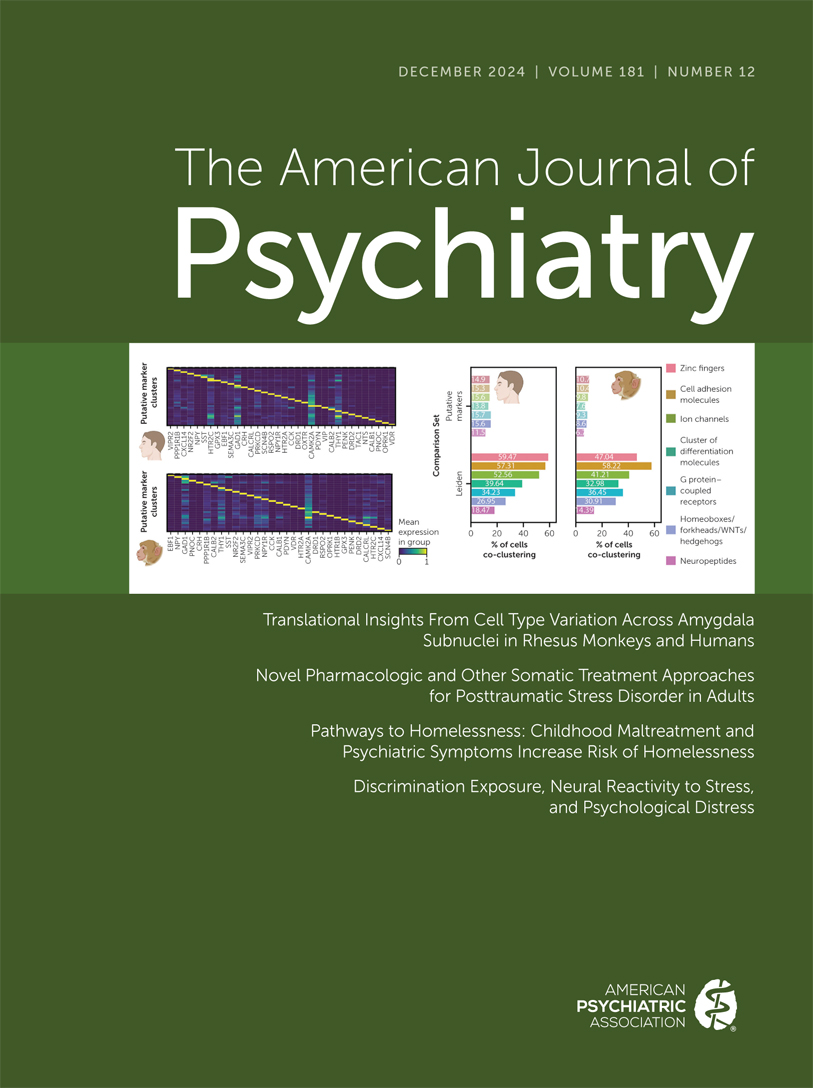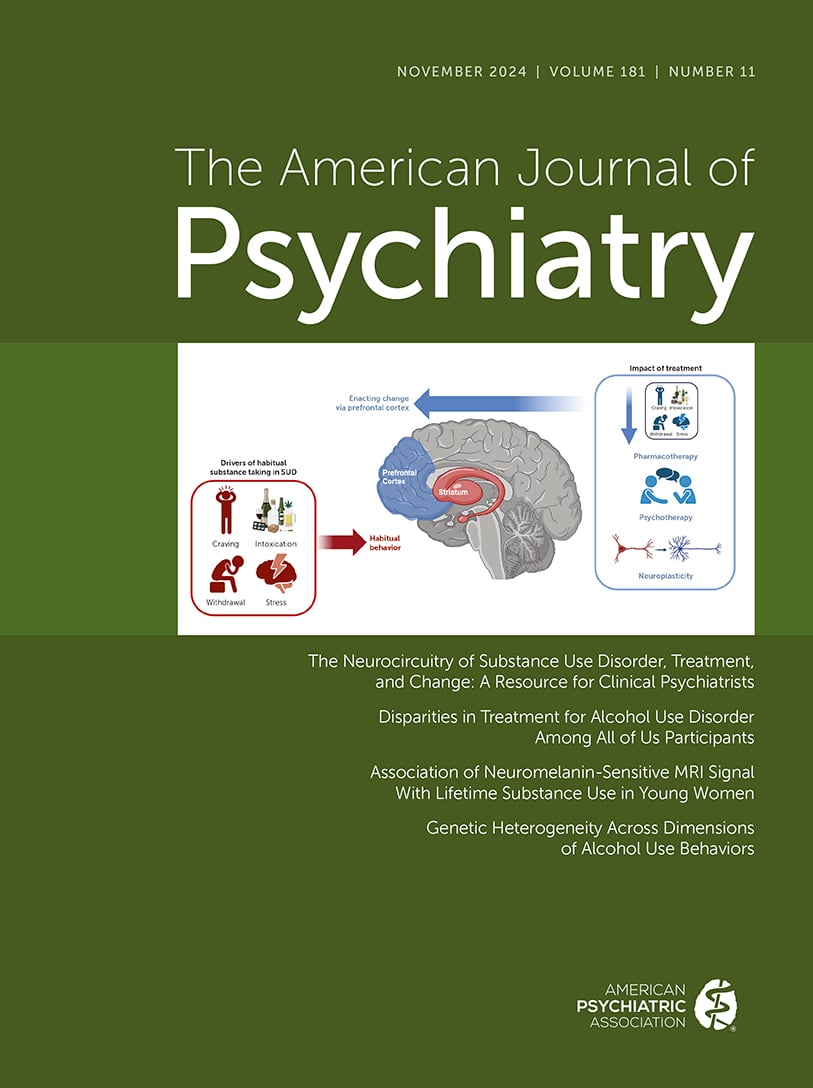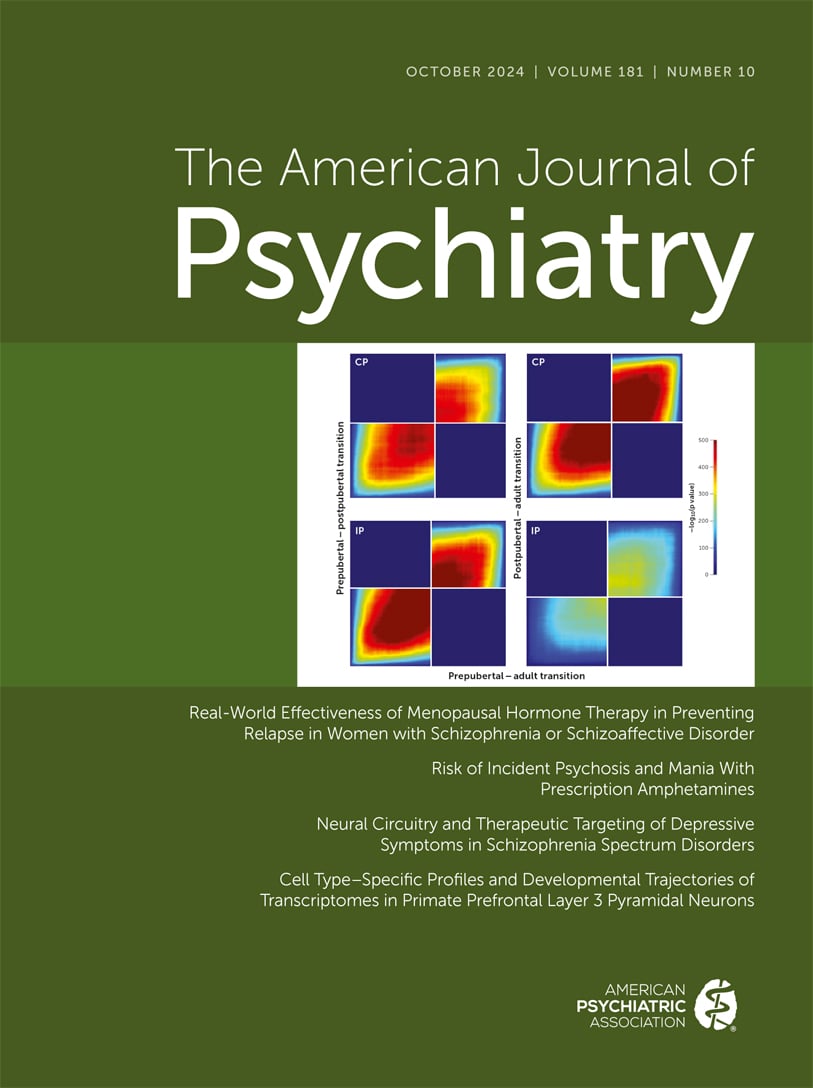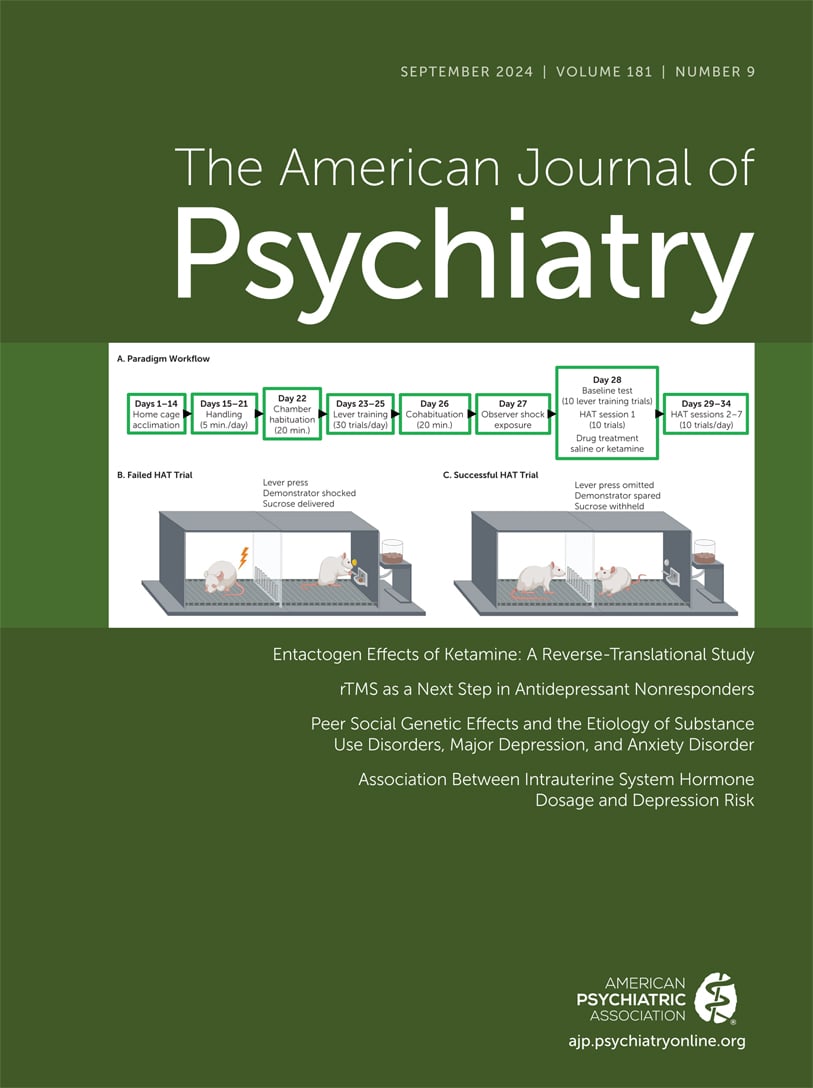American Journal of Psychiatry
- Volume 160
- Number 3
- March 2003
Editorial
Reviews and Overviews
Publication date: 01 March 2003
Pages430–437OBJECTIVE: The authors suggest criteria for a range of narrow to broad phenotypes of bipolar disorder in children, differentiated according to the characteristics of the manic or hypomanic episodes, and present methods for validation of the criteria. ...
https://doi.org/10.1176/appi.ajp.160.3.430Publication date: 01 March 2003
Pages438–449OBJECTIVE: This study reviewed the clinical research and practice literature relating to the prevalence and patterns of concomitant psychotropic medication given to youths with emotional and behavioral disorders. METHOD: A MEDLINE search from 1996 through ...
https://doi.org/10.1176/appi.ajp.160.3.438Clinical Case Conference
Images in Psychiatry
Article
Publication date: 01 March 2003
Pages460–463OBJECTIVE: Genetic factors are the most important risk factors for schizophrenia. However, despite the fact that patients with schizophrenia have significantly fewer offspring than the general population, schizophrenia persists. The authors investigated ...
https://doi.org/10.1176/appi.ajp.160.3.460Do Hypertension and Diuretic Treatment in Pregnancy Increase the Risk of Schizophrenia in Offspring?
Publication date: 01 March 2003
Pages464–468OBJECTIVE: Diuretics prescribed after the first trimester for treatment of hypertension in pregnant women may interfere with normal plasma volume expansion and cause volume depletion. The authors hypothesized that prenatal exposure to diuretics and ...
https://doi.org/10.1176/appi.ajp.160.3.464Publication date: 01 March 2003
Pages469–476OBJECTIVE: There is strong evidence for a genetic contribution to schizophrenia, but efforts to identify susceptibility genes have been largely unsuccessful because of the low power of individual studies. The authors’ goal was to evaluate the collective ...
https://doi.org/10.1176/appi.ajp.160.3.469Publication date: 01 March 2003
Pages477–482OBJECTIVE: The urban environment and familial liability are risk factors for psychotic illness, but it is not known whether a biological synergism exists between these two proxy causes. METHOD: The amount of biological synergism between familial liability ...
https://doi.org/10.1176/appi.ajp.160.3.477Publication date: 01 March 2003
Pages483–489OBJECTIVE: The authors used proton magnetic resonance spectroscopic imaging (1H-MRSI) to assess potential reductions of N-acetylaspartate (a marker of neuronal integrity) in the hippocampal area and dorsolateral prefrontal cortex of patients with ...
https://doi.org/10.1176/appi.ajp.160.3.483Publication date: 01 March 2003
Pages490–495OBJECTIVE: Childhood onset of “adult” psychiatric disorders may be caused, in part, by more salient genetic risk. In this study, the rates of schizophrenia spectrum disorders among parents of patients with childhood-onset and adult-onset schizophrenia and ...
https://doi.org/10.1176/appi.ajp.160.3.490Dimensions of Religiosity and Their Relationship to Lifetime Psychiatric and Substance Use Disorders
Publication date: 01 March 2003
Pages496–503OBJECTIVE: The role of religion in mental illness remains understudied. Most prior investigations of this relationship have used measures of religiosity that do not reflect its complexity and/or have examined a small number of psychiatric outcomes. This ...
https://doi.org/10.1176/appi.ajp.160.3.496Publication date: 01 March 2003
Pages504–512OBJECTIVE: DSM-III imposed a hierarchical relationship in the diagnosis of anxiety disorders in depressed patients, stipulating that anxiety disorders could not be diagnosed if their occurrence was limited to the course of a mood disorder. In the ...
https://doi.org/10.1176/appi.ajp.160.3.504Publication date: 01 March 2003
Pages513–521OBJECTIVE: The objective of the present study was to evaluate the long-term efficacy and safety of capsulotomy in patients with anxiety disorders. METHOD: Twenty-six patients who had undergone bilateral thermocapsulotomy were followed up 1 year after the ...
https://doi.org/10.1176/appi.ajp.160.3.513Publication date: 01 March 2003
Pages522–532OBJECTIVE: Serotonin reuptake inhibitor (SRI) medications are effective in the treatment of both major depressive disorder and obsessive-compulsive disorder (OCD), but it is unknown whether the neural substrates of treatment response for the two disorders ...
https://doi.org/10.1176/appi.ajp.160.3.522Publication date: 01 March 2003
Pages533–540OBJECTIVE: Current drug therapies for generalized anxiety disorder have limitations. In a controlled trial, the novel agent pregabalin was studied for the treatment of patients with generalized anxiety disorder. METHOD: In this double-blind study, ...
https://doi.org/10.1176/appi.ajp.160.3.533Publication date: 01 March 2003
Pages541–546OBJECTIVE: Recent studies of homosexual people have found higher rates of nonfatal suicidal behavior than among heterosexuals. The purpose of this study was to determine associations between self-harm and sexual orientation for men and women separately, ...
https://doi.org/10.1176/appi.ajp.160.3.541Publication date: 01 March 2003
Pages547–554OBJECTIVE: This study describes the prevalence and pattern of use of psychotropic medications by HIV-positive patients receiving medical care in the United States and the search for possible predictors of use. METHOD: The HIV Cost and Services Utilization ...
https://doi.org/10.1176/appi.ajp.160.3.547Publication date: 01 March 2003
Pages555–562OBJECTIVE: Antenatal depression is a significant risk factor for postpartum depression, with a 10%–12% prevalence in all pregnancies. Rates of depression are higher for pregnant women with chronic stressors, financial and housing problems, and inadequate ...
https://doi.org/10.1176/appi.ajp.160.3.555Publication date: 01 March 2003
Pages563–565OBJECTIVE: The purpose of this study was to track the progress of a cohort of graduates of psychiatry residency training programs in achieving certification by the American Board of Psychiatry and Neurology (ABPN). These data provide a detailed picture of ...
https://doi.org/10.1176/appi.ajp.160.3.563Brief Report
Publication date: 01 March 2003
Pages566–568OBJECTIVE: The authors examined possible cerebral gray matter abnormalities in patients with panic disorder. METHOD: Gray matter concentration in 18 panic disorder outpatients and 18 healthy subjects was compared by using a voxel-based morphometry ...
https://doi.org/10.1176/appi.ajp.160.3.566Publication date: 01 March 2003
Pages569–571OBJECTIVE: Childhood-onset schizophrenia shows progressive brain magnetic resonance imaging (MRI) changes during adolescence, which follow a back-to-front “wave.” The authors’ goal was to examine whether healthy siblings of patients with childhood-onset ...
https://doi.org/10.1176/appi.ajp.160.3.569Publication date: 01 March 2003
Pages572–574OBJECTIVE: The purpose of this study was test the hypothesis that abnormalities of inferior frontal white matter are related to the negative symptoms of schizophrenia. METHOD: Fractional anisotropy of white matter tracts in the prefrontal area of 10 ...
https://doi.org/10.1176/appi.ajp.160.3.572Publication date: 01 March 2003
Pages574–576OBJECTIVE: Major depressive disorder is associated with elevated mortality rates that increase with the severity of depression. The authors hypothesized that patients with psychotic depression would have higher mortality rates than patients with ...
https://doi.org/10.1176/appi.ajp.160.3.574Publication date: 01 March 2003
Pages577–579OBJECTIVE: Reduced γ-aminobutyric acid (GABA) concentrations have been reported in the plasma, CSF, and cortex of depressed subjects. Of interest is that ECT, one of the most effective treatments for severe refractory depression, produces considerable ...
https://doi.org/10.1176/appi.ajp.160.3.577Publication date: 01 March 2003
Pages580–582OBJECTIVE: Posttraumatic stress disorder (PTSD) increases the risk of suicidal behavior; a major depressive episode also increases the risk for suicidal behavior. The authors’ goal was to examine the effect of comorbid PTSD and major depressive episode on ...
https://doi.org/10.1176/appi.ajp.160.3.580Publication date: 01 March 2003
Pages582–584OBJECTIVE: The influence of psychiatric symptoms and cognitive impairment on daily living skills was explored in a series of nursing home residents. Three categories of symptoms were examined: behavioral disturbances, depression, and delusions. METHOD: ...
https://doi.org/10.1176/appi.ajp.160.3.582Publication date: 01 March 2003
Pages585–587OBJECTIVE: Acute stress disorder permits early identification of trauma survivors who are at risk of developing chronic posttraumatic stress disorder (PTSD). This study aimed to prevent PTSD in people who developed acute stress disorder after a mild brain ...
https://doi.org/10.1176/appi.ajp.160.3.585Letter to the Editor
Book Forum: Psychological and Physical Trauma
Book Forum: The Physiology of Stress
Book Forum: Mind, Body, and Behavior
Book Forum: Historical, Philosophical, and Religious Perspectives
Book Forum: Borderline Personality
Correction
Past Issues
View Issues Archive
Vol. 181 | No. 12

Vol. 181 | No. 11

Vol. 181 | No. 10
